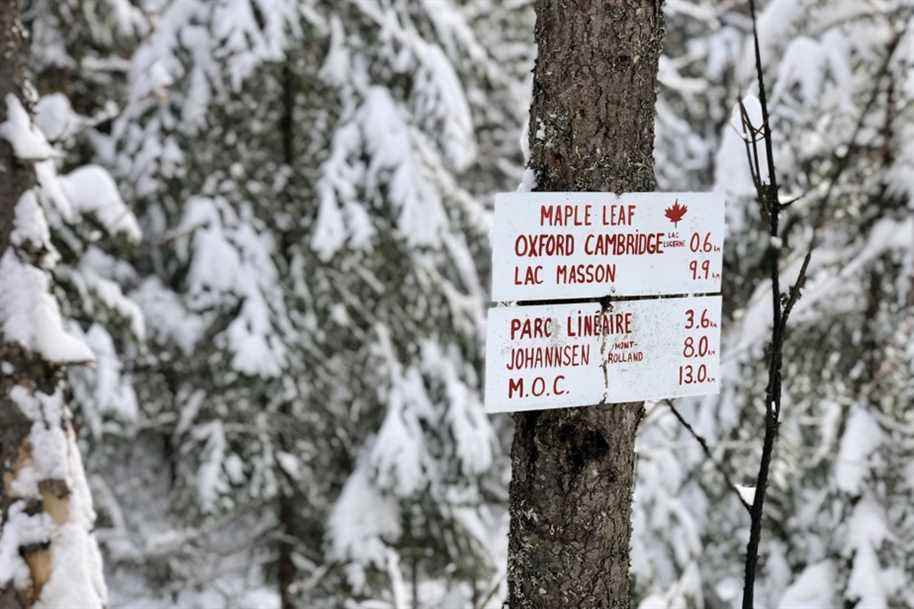The famous heritage Nordic ski trails in the Laurentians are increasingly fragmented, in particular due to the construction of homes. But there is no question of giving up: stakeholders are in the process of refining a 10-year plan which, they hope, should make it possible to perpetuate part of this historic network.
Posted at 11:30 a.m.
Outdoor clubs, MRCs, municipalities, federations, groups… many of them are helping out.
“Something needs to happen urgently,” says former mayor of Val-David Kathy Poulin, who is part of the core group of enthusiasts working on the project. “It is almost too late, but there is still a way to intervene. »
The development of the Laurentians is closely linked to that of these great Nordic ski trails, recalls Daniel Bergeron, member of the board of directors of Plein air Sainte-Adèle and instigator of the project.

IMAGE PROVIDED BY OUTDOOR SAINTE-ADÈLE
A portion of a 1948 Nordic ski trail map. Red lines represent trails, orange lines represent roads.
These great trails, like the Maple Leaf Trail, the Western and the Gillespie, connected villages, hotels, resorts. “In the 1940s, the entire ski network was 1,600 km long,” says Mr. Bergeron. It is presently in the process of atrophying. »
The network has been under pressure for a long time. This is how the construction of Highway 15 eliminated a large part of the Maple Leaf Trail, which linked Shawbridge to Labelle. At present, it is mainly building construction that threatens sections of trail. There are also new owners who suddenly forbid passage on their property. This happened recently on the Gillespie trail. “Fortunately, a neighbor sympathetic to the cause accepted that the path be diverted on his property, indicates Mr. Bergeron. But again, we reacted. »

PHOTO PROVIDED BY ANDRÉ GOULET
The Maple Leaf Trail connected Shawbridge to Labelle. Several sections have disappeared over time, but others still delight skiers.
Climate change also gives headaches: several heritage trails pass over lakes and marshy environments. These portions could therefore be impassable during very mild winters, especially in the southern Laurentians.
“The idea would be to have an alternative bypass,” says André Goulet, of the Institut des Territoires, a conservation organization. “But at the same time, it will be important to keep the original routes because it is often the lakes that allow skiers to position themselves. »
The stages of the project
Thanks to a grant from the Ministry of Municipal Affairs, the early partners hired the Institut des Territoires and Mr. Goulet to plan the project. The first step was to arouse the interest of the population. It didn’t take long: a Facebook post from the Institut des Territoires generated enormous enthusiasm. It has been read, shared and commented on by tens of thousands of people.
The second step consists in targeting about fifteen trails which will be prioritized. “We are working democratically on this,” says Mr. Goulet.
An expanded committee was created to identify trails based on cultural criteria and criteria of functionality and interconnectivity.
André Goulet, from the Territory Institute
As the participants in these discussions are often people in the field, they know the condition of the trails well and can target the sections that will be more difficult than others to sustain.
The next steps will focus on establishing a budget and creating a regional body that could oversee the project. Then, we will get to the heart of the matter: sustainability itself, which will require a well-stocked toolbox. “Sustainability will use urban planning, economic, ecological, cultural and political tools”, lists Daniel Bergeron. “And even legal, adds Kathy Poulin, former mayor of Val-David. There are owners who really don’t want to. It may be necessary to go for legal protection, in the same way as heritage buildings. »

PHOTO PROVIDED BY ANDRÉ GOULET
The arrival of new owners sometimes leads to the loss of sections.
When we talk about cultural tools, we are talking about designating the practice of Nordic cross-country skiing in the Laurentians as part of the intangible heritage of Quebec.
Protected areas
Ecological tools include the creation of protected areas. “Linear sustainability will not be enough,” says André Goulet.
Actions will have to be taken to conserve large natural areas, as Val-David did with Parc Dufresne.
André Goulet, from the Territory Institute
We can also think of ecological gifts, a tax solution that may interest owners who pay a lot of taxes in other facets of their lives. We could also create easements or outright buy portions of land.
It is therefore a long-term project.
The pandemic has demonstrated the importance of better access to nature. However, it has created additional pressure on real estate construction in the Laurentians, with all these teleworkers who now want to live in the region.
However, Kathy Poulin sees the situation with optimism. “What attracts these new residents is the access to nature. It must therefore be protected. It’s a great lever. »
Suggested video
Skating on lace
Freeze and thaw periods have created graceful patterns on this New Hampshire lake.
digit of the week
1300
This is the number of lemmings that a brood of nine snowy owl chicks eats in a month. Parents have a job to feed these little guzzlers.

